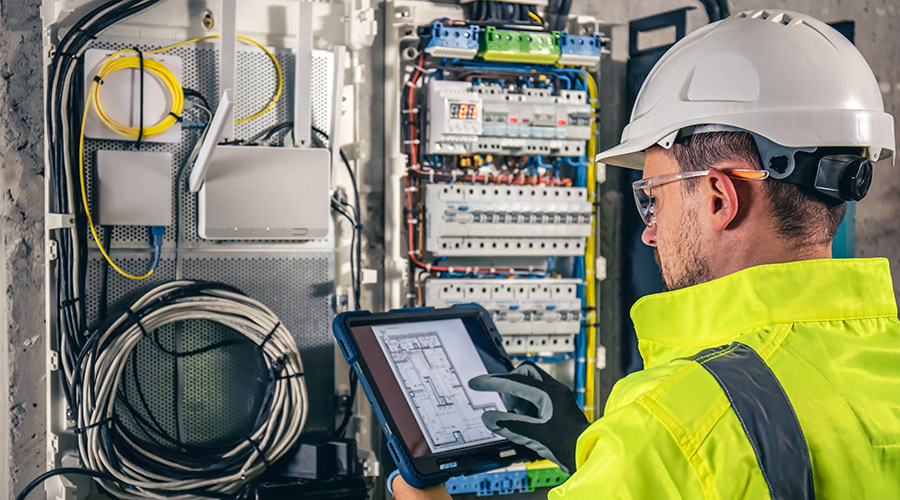Each year, more than two million people contract a hospital-acquired infection (HAI) that can also be antibiotic-resistant. In 2013, these infections resulted in at least 23,000 deaths (CDC). In fact, HAIs, kill more people than AIDS, breast cancer and auto accidents combined.
Emerging diseases—such as Sudden Acute Respiratory Syndrome (SARS) and Middle East Respiratory Syndrome (MERS)—demand vigilance by healthcare facilities to protect workers, facility staffs, patients and visitors from the spread of these pathogens.
There is, essentially, a war being fought on three fronts of infection control: HAIs, antibiotic resistant microorganisms (ARMs) and emerging diseases.
Engineering for infection-control systems in healthcare facilities plays a pivotal role in fighting this battle. Guidelines exist, such as the ANSI / ASHRAE / ASHE Standard 170-2013, Ventilation of Health Care Facilities (ASHRAE 2013); however, no single guide encompasses all of the information and/or proven suggestions engineers will need.
Because Ultraviolet Germicidal Irradiation (UV-C) kills all known microorganisms, this article outlines some basics of infectious diseases and points to engineering-level guidance for continuously reducing, or in some cases, preventing infectious pathogens from growing on or circulating in hospital spaces and HVAC systems.
Basics
It helps to know pathogen types and how they are manifested as diseases (etiology), which includes virulence (how it affects people); its transmission (how they’re spread), and which interventions are shown to work best for which diseases.
Types
We’ll focus on two types of pathogens that are of concern – bacteria and viruses.
•Bacteria. Bacteria inhabit soil, water and humans, etc. and are responsible for strep throat, urinary tract infections and tuberculosis to name a few. A growing issue with bacteria is their resistance to available drugs, and these are known as antibiotic resistant microorganisms (ARMs), such as MRSA (Methicillin-resistant Staphylococcus aureus).
•Virus. Viruses are small infectious agents that replicate in living cells of other organisms such as in humans, animals and plants. They are typically smaller than bacteria, and are difficult to treat with drugs.Viruses include Ebola, and coronaviruses (Enterovirus D68), SARS, MERS and colds and flu.
Transmission
This basic knowledge provides a foundation to design interventions that intercept or interrupt, and therefore reduce the risk and spread of infectious agents. There are many forms of transmission; those covered are outlined below.
Methods include (but are not limited to) the following:
•Direct contact: Physical contact and transfer of microorganisms that occurs during touching, kissing, and contact with blood and other bodily fluids (Mt. Sinai 2014).
•Indirect contact: Contact with a contaminated surface, such as doorknobs, bed rails and medical instruments, etc. (Mt. Sinai 2014).
•Droplet contact: Infested droplets generated by an infected person by breathing, coughing, sneezing or talking, and directly reaching another person’s eyes, nose or mouth. Droplets can also be generated during bronchoscopy, surgery, autopsy, and other medical procedures (Mt. Sinai 2014).
•Airborne transmission: droplet nuclei and/or residue from evaporated droplets or dust particles containing microorganisms, all of which can remain and survive suspended in air for long periods of time, and some are resistant to drying out.
•Fecal-oral transmission: Digestive tract microorganisms can be spread to food, water or medicine and ingested by another person, or spread through indirect contact with flushing toilets and medical instruments.
•Close contact: A term used today as the means of transmission of the Ebola virus. According to the CDC, ‘close contact’ includes caring for or living with an infected person; having direct contact with a patient’s respiratory secretions or bodily fluids; sharing eating or drinking utensils, or touching someone directly. Close contact does not include walking by a person or briefly sitting across in a waiting room as examples.
Virulence, infectiveness and treatability
Virulence is the potential to impact an infected person’s health, including mortality rate or, how many people die after becoming infected. Apart from pathogen specifics, virulence depends on many factors, including age, health, vaccinations, and the patient’s access to healthcare.
Infectiveness is a disease’s ability to spread. The term “reproduction number” (R0) is used to numerically rate the infectiveness of treatment. The higher the R0, the more contagious the disease.
Treatability is an informal term that means the difficulty to treat an infection with vaccinations or medicines. Viruses are difficult to treat, bacterial infections once treatable with antibiotics are now mutating into multidrug-resistance forms (WHO 2014).
The War
As previously mentioned, the war against diseases is being waged on three fronts – hospital-acquired infections; anti-microbial resistance to known drugs and emerging diseases.
Hospital-Acquired Infections (HAIs)
HAIs are high in U.S. hospitals. Research on U.S. acute-care hospitals by the CDC found that in 2011, about 1 in 25 patients had at least one healthcare-associated infection. This amounts to about 722,000 HAIs during 2011 and about 75,000 of those infected, died during their hospitalizations. More than half of these infections occurred outside of an intensive care unit (Magill 2014).
Furthermore, diseases normally spread via air or by contact, can also spread by alternative transmission routes. For example, the Clostridium difficile (C. diff) bacterium, a common HAI pathogen, is usually spread through fecal-oral transmission. However, several studies have found that it can become airborne during room cleaning to spread both within and outside a room (King 2012, Best 2010).
HAIs and Medicare
The prevalence and costliness of hospital-acquired infections has not gone unnoticed by Medicare administrators. Two Medicare payment adjustments have been put in place to increase pressure on hospitals to reduce HAIs through preventive measures.
The first was established in 2006 with the Deficit Reduction Act (DRA) that contained language such that after “October 1, 2008, hospitals will not receive additional payment for cases in which one of the selected conditions were not present on admission.” (NCSL 2008). This began, in collaboration with the CDC, to establish tracking and nonpayment of selected HAIs. The program was developed to increase in stringency over time.
The second was established in 2013 when the Centers for Medicare & Medicaid Services (CMS) instituted the Hospital Value-Based Purchasing Program, which pays more to hospitals with performance indicators above a threshold considered “good” and less to hospitals below the threshold (CMS 2014). In the program, payment adjustments are developed using a methodology that includes “hospital acquired conditions,” some of which are selected hospital-acquired infections. In 2014, 1,451 hospitals began a period of receiving reduced payments for each Medicaid patient they treat for one year beginning October 1, 2014. Bonuses in payments to 1,231 hospitals will also occur during the same time period (Rau 2014). Increasing stringency over time also is expected in the program.
Antibiotic Resistance
Resistance of pathogens to medicines is occurring at a shocking rate, and no major new antibiotics have been developed in the last 30 years (WHO 2014). The situation elicited a warning from the World Health Organization: “Without urgent action we are heading for a post-antibiotic era, in which common infections and minor injuries can once again kill” WHO 2014).
In 2014, the President’s Council of Advisors on Science and Technology released a report on antibiotic resistance (PCAST 2014) stating that the “evolution of antibiotic resistance is occurring at an alarming rate and is outpacing the development of new countermeasures.” The report’s strategies included improved stewardship of antibiotics (reducing unnecessary use of antibiotics); increased surveillance of antibiotic-resistant strains of bacteria for earlier identification of outbreaks; limiting the spread of resistant organisms; and accelerating the development of new antibiotics (PCAST 2014).
It’s unclear when the focus on antibiotic-resistant bacteria will take place or whether it will yield results. While these efforts are ramping up, hospitals will need to continue to refine their protocols and infrastructures to protect against antibiotic-resistant bacterial infections and outbreaks.
To help fight this battle, and the battles on the fronts of emerging diseases and hospital-acquired infections, engineers have one major and extremely well-tested tool they can turn to, Ultraviolet Energy in the “C” band, a broadly-used technology that kills bacteria and virus in room air and in HVAC supply air streams and surfaces.
Emerging diseases
Emerging diseases are a threat because they skirt treatment by masquerading as known diseases with similar symptoms. Instead of being a known variant of, say the cold or flu, it may be a new pathogen or disease, more virulent and/or infectious genetic variant of a known disease.
The impact of emerging diseases is not always identical in different countries. U.S. healthcare workers exposed to SARS did not contract the disease. However, in other countries, there were infections, sufficient to close a hospital.
Ebola has been extremely detrimental to healthcare workers. As of Sept. 23, 2014, the World Health Organization reports that more than 240 healthcare workers have died from the disease, some of whom were their countries’ most prominent doctors (WHO 2014-2).
Infection Control
The UV-C waveform is a supplemental and extremely effective approach to fighting infectious diseases (Memarzadeh 2010). No known microorganisms are completely resistant to the physical effects of the UV-C frequency.
UV-C can be installed inexpensively throughout healthcare facilities by using upper-room units for interior spaces, lamps in HVAC ducts and exhaust systems for airstream disinfection and in air handlers to disinfect airstreams, coils, air filters, drain pans and other potential reservoirs for microbial growth and proliferation.
The following is intended for applications that focus on airborne transmission and transmissions that have airborne components.
Fortification
UV-C supplements infection-control protocols for disinfection, sterilization and manual cleaning. In addition to their 24/7 operation of killing pathogens, they also provide some level of protection when staffs do not, or cannot follow protocols, or if existing protocols are sidestepped by emerging diseases and when HVAC or room-pressurization systems are compromised.
A “fortification” approach is another level of protection. Again, UV-C is effective against all pathogens from either emerging or known diseases, and it does not contribute to drug resistance or secondary contamination.
UV-C installations are positioned in key spaces and/or HVAC equipment where pathogen sources and pathways exist. Interior and perimeter spaces are protected using upper-room units. Air handling systems serving high-risk areas are protected using airstream-disinfection systems. And areas of HVAC systems known as reservoirs of pathogens are bathed with surface-cleaning UV-C systems.
Upper-Air Units
Infections from airborne pathogens (which fall out or plate out onto equipment surfaces and floors) are sourced by people (Nardell 1999). Upper-air UV-C systems reduce these microorganisms by effectively intercepting them in the room air (First 1999).
Another use is to intercept microorganisms from other sources or where cross-contamination pathways exist. They kill pathogens circulated into its plane by drafts, pressure differentials or the movement of people, such as entering or leaving a room or from cleaning. They are also effective against droplet nuclei from coughing, sneezing or the changing of bed linens.
Upper-room units are installed in patient rooms, emergency rooms, waiting rooms, isolation rooms/wards, surgery suites and childcare rooms—anywhere infectious agents exist. Guidelines are available from the National Institute for Occupational Safety and Health (NIOSH 2009) or from manufacturers.
Air-Stream Disinfection
Airstream disinfection systems employ UV-C lamps to target pathogens from outdoor and/or return air (which contain airborne pathogens). Kill ratios over 99.9% on a first-pass basis have been modeled and, as air is re-circulated, concentrations are further reduced by each subsequent pass (mass balance).
Airstream disinfection is used in high-risk areas, such as surgical suites, neonatal care centers and isolation rooms/wards. Guidance may be found in ASHRAE handbooks, as well as the Ultraviolet germicidal irradiation handbook (Kowalski 2009).
Notable applications include the Pentagon for protection against bio-terror agents, the CDC for protection against catastrophic spillages of infectious agents and the isolation units at Emory University hospital, where Dr. Kent Brantly and Nancy Writebol, who both were infected with Ebola, were taken to recover.
HVAC Surface Cleaning
Surface-cleaning UV-C systems provide 24/7 irradiation of HVAC components to destroy bacteria, viruses and mold that settle and proliferate on coils, air filters, ducts and drain pans. UV-C prevents them from becoming microbial reservoirs for pathogen growth and subsequent entrainment into airstreams. They also provide first pass kill ratios of airborne pathogens of up to 30%, with ancillary benefits of restored cleanliness, heat exchange efficiency and energy use (ASHRAE 2011- Fencl 2013/2014).
HVAC surface-cleaning was recently documented in a neonatal intensive care unit (NICU) case study at the University of Buffalo Women and Children’s Hospital (Ryan 2014). The study found substantial reductions in microbial loading on NICU surfaces to near 0 cfu after four months of operation. The study concluded that “decreased HVAC microbial colonization was associated with reduced NICU environment and tracheal microbial colonization. Significant reductions in VAP [ventilator-associated pneumonia] and antibiotic use were also associated with UV-C” in this study.
Summary
Healthcare leaders are uniting in this war against infectious diseases. The toll in human lives, lost productivity, healthcare costs and healthcare resources is huge. Although focused efforts are underway to address new medicines, surveillance systems, and diagnostic procedures, the outcome of these efforts is unknown, and, there will always be the need to circumvent any new measure from error, negligence and the unceasing genetic mutations and evolutions that bacteria and viruses can undergo.
UV-C systems are a cost-effective, proven, and a readily available means to address all three fronts of the war on infectious diseases. The variety of ways that UV-C can be applied enables engineers and operators to tailor UV-C technologies to meet desired outcomes, and doing so within real-world budgets.
As examples, Upper-Air UV units cost as little as $2.50 - $3.10 per square foot of treated space. Air-stream Disinfection systems range from $0.60 - $0.80 per cfm and HVAC Surface Disinfection systems are approximately $0.10 - $0.15 per cfm, literally bargains when compared to human lives, lost productivity, healthcare costs and healthcare resources.
Forrest Fencl is president of UV Resources, Santa Clarita, Calif.
Shortcuts to Infection Information:
Hospital acquired infections: http://www.cdc.gov/hai/
Antimicrobial-resistant microorganisms: http://www.cdc.gov/drugresistance/
Emerging diseases: http://www.cdc.gov/ncezid/
Ebola: http://www.cdc.gov/vhf/ebola/
Middle East Respiratory Syndrome (ERS): http://www.cdc.gov/coronavirus/mers/
Non-polio Enterovirus 68: http://www.cdc.gov/non-polio-enterovirus/index.html
Morbidity and Mortality Weekly Summary Report: http://www.cdc.gov/mmwr/
Coronovirus (including SARS and MERS): http://www.cdc.gov/coronavirus/about/index.html

 How Architects Shape the Future of Healthcare Facilities
How Architects Shape the Future of Healthcare Facilities UNC Health, Duke Health Form Partnership for Stand-alone Children's Hospital
UNC Health, Duke Health Form Partnership for Stand-alone Children's Hospital Sarasota Memorial Hospital Plans to Build New Facility in North Port
Sarasota Memorial Hospital Plans to Build New Facility in North Port CMMS, Data and the Path to Compliance
CMMS, Data and the Path to Compliance Healthcare is a Major Ransomware Target
Healthcare is a Major Ransomware Target